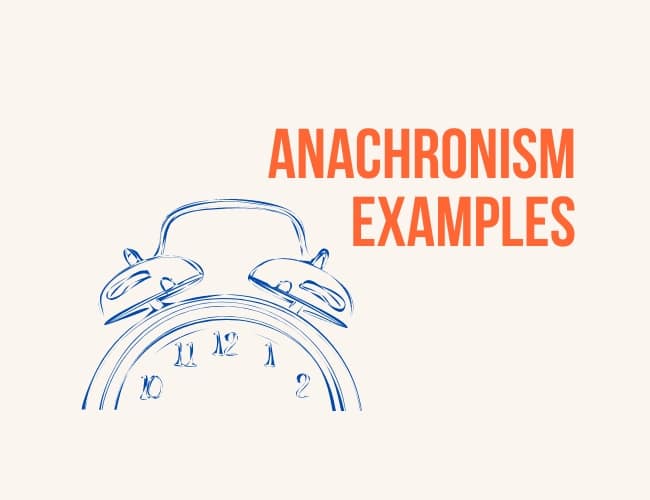Imagine writing a story set in Dickens' 19th century, Victorian England, and your Scrooge spin-off answers his cell phone, “Wassup?” Or your knight in 13th century France uses phrases like, “spilling the tea.” Those are anachronisms, and they would likely startle contemporary audiences out of the story. Let's look at the definition of anachronism, types of anachronism, and anachronisms in your story.

Anachronism definition
An anachronism, according to Merriam-Webster, is an object, event, person, or custom out of its proper time in relation to the context. In the examples above, cell phones and “spilling the tea” are in the wrong time period. An object or phrase from the 21st century has been placed in an earlier time.
If we break the word apart, we have three elements. The prefix “ana-” means against; “chron-” (from Greek khronos) is time; the suffix “-ism” signifies the practice of something. When we put them together, we have “an error in computing time or finding dates.”
Anachronisms aren't just when something from the future slips into the past. If my modern-day heroine, for example, wants to pay with a $500 bill, she's in trouble. They stopped printing them in 1969.
Types of anachronism
Now that we have a basic definition of anachronism (something chronologically out of place), let's look at kinds of anachronism.
Parachronism
A parachronism is something that doesn't belong in a later time period, often one that isn't absolutely impossible. Modern use of a $500 bill is a parachronism. Possible, but not likely. Another example would be visiting the Crystal Palace in London after 1936, when a fire destroyed it. A modern character calling something “the bee's knees” or “the cat's pajamas” is another parachronism.
Prochronism
A prochronism, on the other hand, is something from the future that didn't exist at the time being described. Cell phones in William Shakespeare's plays would be a prochronism, just like cocoa, tea, or coffee in 14th century Europe.
These popular drinks were introduced in 1528, 1610, and 1615, respectively. Painters in the Middle Ages and later often depicted historical figures, such as King Arthur, in plate armor when it didn't exist during his time period.
Prochronism also occurs in modern film. In Braveheart, the Scots wear kilts, which were not introduced until 200 years after William Wallace died. Unlike parachronism, prochronism constitutes an impossible anachronism.
Behavioral anachronism
Behavioral anachronism, also called cultural anachronism, refers to actions and attitudes that are foreign to the time period but can't be ruled out completely. One often-used example is women in certain professions.
Once in a while, we come across accounts of women masquerading as men in these professions, but driving stagecoaches and going to war were male pursuits—Amazons to the contrary. Mulan is a case in point. She disguises herself as man, but the acceptance she receives when the deception is revealed is cultural anachronism.
False anachronism
Then we have false anachronisms. These are when we're certain the word, phrase, or artifact is out of place, but it isn't. One instance is so famous that it gives its name to the idea: “The Tiffany Problem.”
Let's say you love the name Tiffany, so you give it to your 10th century heroine. Now you've committed a horrible anachronism, right? Wrong. The name Theophanu, or Theophania, and its short form, Tiffany, were popular in the Middle Ages. Otto II, Holy Roman Emperor, married a Byzantine princess named Theophanu.
She was a formidable woman, the only woman named co-empress in the history of the empire. (There's that cultural anachronism about women in male occupations, which turns out to be false in this case.)
Another name that sounds modern but was common in medieval times is Jordan. Alfons Jordan of Toulouse brought the name to the South of France in the 12th century, where it became popular.
Anachronism examples
Even famous authors (and painters and filmmakers) commit anachronisms. We find examples of anachronism in art, in film, and in literature.
Albrecht Dürer depicting the Imperial Crown of the Holy Roman Empire on Charlemagne's head is an anachronism in art.
In addition to King Arthur in plate armor and Mel Gibson's William Wallace in a kilt, anachronisms in film include German shepherds in Gladiator, “We Will Rock You” in A Knight's Tale, and a Hollywood movie set in Mel Brooks's Blazing Saddles.
William Shakespeare's works contain many anachronisms. Julius Caesar, gives us verbal references to doublets, but ancient Romans wore togas. And they didn't have clocks. Cleopatra, in Antony and Cleopatra, is invited to play billiards, even though the game was not invented until over 1,000 year after her death.
Mark Twain deliberately introduces anachronisms into A Connecticut Yankee in King Arthur's Court. It's a time travel adventure, and the time traveler brings modern ideas with him. Twain wasn't terribly interested in historical accuracy.
And that brings up the question:
Should I avoid anachronism in my story?
It depends.
An author's goal is to engage readers, so ask yourself if the anachronism will keep readers engaged in the story or pop them out of it.
This applies to false anachronisms as well as deliberate anachronisms and unintentional anachronisms.
Let's go back to Tiffany and Jordan for a moment. You proclaim their historicity for your story. Your reader says, “That can't be right,” goes off to investigate, and discovers you knew what you were talking about. Great, right? Two problems: your reader abandoned their suspension of disbelief, and they put your book down. You don't want that.
On the other hand, you may want to include an intentional anachronism or two in your story for several reasons. Perhaps for humorous effect or social commentary. Go for it.
Beware of unintentional anachronisms, though. They can lose you readers fast. How can you avoid them?
Do your research.
Read in your genre.
Join a community like The Write Practice and solicit feedback.
Have you seen other examples of anachronism in books, art, or film? Share in the comments.
Want to find even more practice with grammar and literary devices? We share an article a week to help you hone your skills. See our newest grammar and literary device articles here.
PRACTICE
Now it's time to practice. Spend 15 minutes writing a vignette in which you deliberately include anachronisms, so you know what they look and feel like.
When finished, share in the Pro Practice Workshop, and leave feedback for a few fellow writers.

Robert Harrell
Robert Harrell is a grammar nerd—and a language teacher, medieval re-creationist, musician, traveler, and theologian. His interests inform his stories and coaching. Published in German, Spanish, and French, with two English-language YA/NA series underway, Robert is pursuing The Write Practice Book Coach Certification to help other writers excel. Learn more at his website.



0 Comments